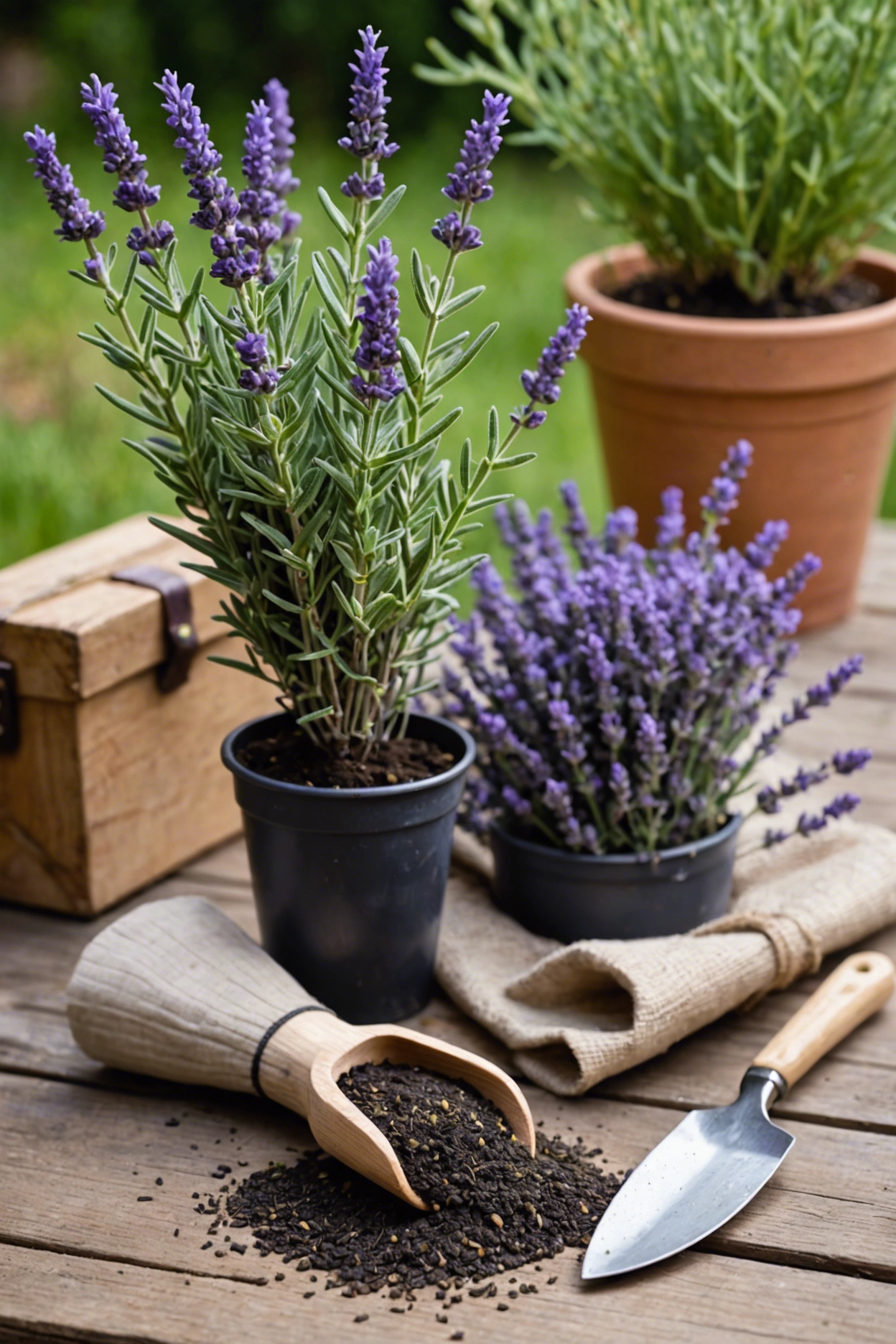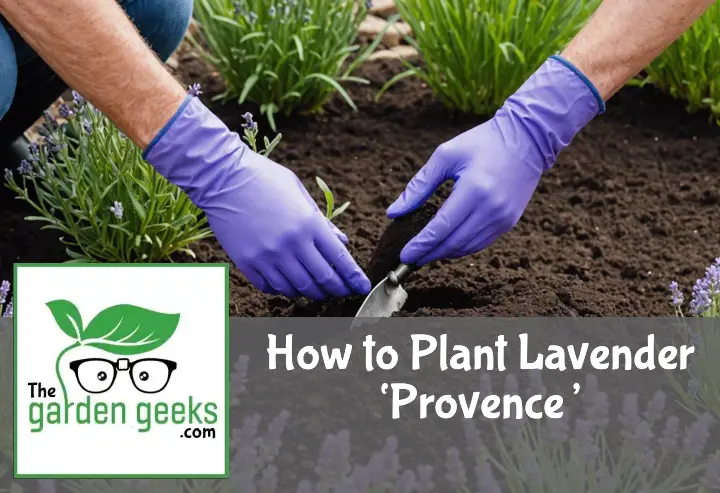Did you know that Lavender ‘Provence’ can grow up to 3 feet tall and spread over 4 feet wide? This variety of lavender is not only known for its delightful fragrance, but also its remarkable resilience.
If you’ve ever wondered How to Plant Lavender ‘Provence’, then you’re in the right place. With the right guidance, even a novice gardener can successfully grow this aromatic plant.
In this blog post, we will guide you through the process step by step. So keep reading about How to Plant Lavender ‘Provence’.
Quick Answer
- Understanding Lavender ‘Provence’: This variety is known for its strong fragrance and tall, vibrant purple spikes. It thrives in full sun and well-drained soil.
- Preparing to Plant: Choose a sunny location with good drainage. Prepare the soil by adding compost or organic matter if needed.
- Planting Steps: Dig a hole twice as wide as the root ball, place the plant in, then backfill with soil. Water thoroughly after planting.
- Post-Planting Care: Water regularly but don’t overdo it. Prune lightly in spring to encourage bushy growth.
- Harvesting: Cut flower spikes when they’re fully bloomed, usually in late summer. They can be used for various purposes like making essential oils or dried bouquets.

Understanding Lavender ‘Provence’
Characteristics of Lavender ‘Provence’
Lavender ‘Provence’ is a real show-off. It’s got these features of Lavender ‘Provence’ that make it stand out. First off, the color. It’s like the sky at dusk, a soft purple that seems to glow. And it grows big, really stretching out.
But wait until you smell it. The scent? Heavenly. Imagine walking through a field in France, that’s what your garden will feel like. This lavender doesn’t just look good; it works hard too, growing in neat patterns that make your garden look organized without even trying.
Ideal Growing Conditions for Lavender ‘Provence’
Getting this beauty to thrive isn’t rocket science but pay attention to its needs. Lavender ‘Provence’ loves the sun, like basking-in-the-sun-all-day kind of love. So, find it a sunny spot where it can soak up those rays.
Now, the soil – it’s picky about this. It prefers things on the lighter side, well-draining soil where its roots can breathe easy. Think sandy or loamy stuff that doesn’t hold water for too long.
Temperature-wise, it’s pretty chill but doesn’t frost its style – keep it warm if you can. Watering needs are on the low; overdo it and you’ll see it sulk. Just enough to keep it from getting thirsty will do.
Remember these tips and watch your Lavender ‘Provence’ flourish, bringing a bit of Provencal charm right to your doorstep.
Preparing to Plant Lavender ‘Provence’
Before you start, know this: Lavender ‘Provence’ loves the sun and hates wet feet. So, let’s get our ducks in a row for a successful lavender plantation.
Selecting the Right Location
Picking where to plant your lavender is like choosing the best sunny spot at the beach. It needs lots of sunlight, at least 6 hours a day. Think of a place in your garden that gets plenty of sun; that’s where your lavender wants to be.
Now, let’s talk about drainage because lavender does not like soggy roots. If you have heavy clay soil, consider raising your bed or planting on a slope. This helps water run away from the roots instead of drowning them.
The perfect spot is also somewhat protected from harsh winds but still gets good air circulation. It sounds picky, but it’s all about giving your lavender plants the best chance to thrive.
Soil Preparation and Requirements
Lavender isn’t too fussy about soil as long as it’s well-drained. But if you want to see it really flourish, aim for a soil pH between 6.5 and 7.5. You can easily test your soil’s pH with a kit from your local garden store.
If you find out your garden is more on the acidic side, don’t sweat it! Just mix in some lime to raise the pH level. For those dealing with alkaline soil, adding sulfur will help lower the pH.
Adding organic matter? Go easy on it! Too much can make the soil too rich for lavender’s liking. A bit of compost or aged manure is fine but remember, when it comes to feeding lavender, less is more.
Lastly, if your soil is super compacted, grab a fork (not the kind you eat with) and give it a good turning over. This will help improve drainage and make it easier for those lavender roots to spread out and get comfy.



How to Plant Lavender ‘Provence’


Planting Lavender ‘Provence’ is like inviting a piece of the French countryside into your garden. This section will guide you through each step, ensuring your lavender plants thrive and fill your garden with their soothing fragrance and vibrant colors.
-
Select the right spot in your garden. Lavender ‘Provence’ loves the sun, so find a place that gets at least 6 hours of direct sunlight every day. The more sun, the better!
-
Test your soil to make sure it’s just right for lavender. Lavender ‘Provence’ prefers well-draining soil with a pH between 6.5 and 7.5. If your soil is too clayey or too acidic, consider adding some sand or limestone to improve drainage and adjust the pH level.
-
Plan the layout before you start digging. Lavender plants need space to breathe and grow, so place them about 18 to 24 inches apart from each other. This spacing ensures good air circulation and reduces the risk of disease.
-
Dig a hole for each plant that’s slightly larger than the root ball but not deeper. You want to avoid burying the plant too deep as this can lead to root rot.
-
Mix some compost into the soil you’ve removed if it needs a nutrient boost. A handful per hole should do it, but don’t overdo it—lavender isn’t a big fan of very rich soil.
-
Remove the lavender plant from its pot gently, being careful not to damage its roots. Loosen any tightly bound roots lightly with your fingers to encourage them to spread out in their new home.
-
Place the plant in the hole, making sure that the top of the root ball is level with or slightly above ground level. Backfill with soil, pressing down lightly around the base of the plant to eliminate air pockets.
-
Water thoroughly after planting, giving your lavender a good drink to help settle any remaining air gaps around its roots.
-
Mulch lightly around but not on top of your lavender plants using gravel or small stones rather than organic mulch like wood chips or leaves; this helps keep moisture away from their bases and prevents rot.
-
Finally, give your new lavender plants time to acclimate and grow strong without too much fussing over them; they’re quite independent once established! Regular watering during their first growing season helps them develop deep roots, but once they’re settled in, they’ll be fairly drought-tolerant.
Caring for Your Lavender ‘Provence’ Post-Planting
Taking care of your Lavender ‘Provence’ after planting is like making sure a tiny puppy grows up healthy and strong. It’s all about the right amount of water, food, and grooming.
Watering and Feeding Schedule
When it comes to watering Lavender ‘Provence’, think of it as a camel. It doesn’t need a lot of water to thrive. In fact, too much water can make it super unhappy. Aim for once a week if the weather is dry, but if you’ve got rain, let nature do its thing.
Now, feeding this plant is not like feeding a hungry teenager. Lavender isn’t greedy. A little bit of compost or slow-release fertilizer in spring is all it needs to keep blooming and smelling great.
Remember, overdoing it with water or food can lead to trouble. Stick to the just-right amount, and your lavender will be on cloud nine.
Pruning and Maintenance Tips
Pruning Lavender ‘Provence’ is like giving it a nice haircut. It keeps the plant looking good and prevents it from getting too wild. The best time to do this is in early spring or after it blooms.
Cut back about one-third of the growth to encourage new flowers and keep the shape neat. But don’t cut into the woody part; stick to the green stems.
Keeping an eye on your lavender for pests or diseases is also key. Luckily, Lavender ‘Provence’ is pretty tough and doesn’t get sick easily.
Regular pruning not only makes your lavender look tidy but also helps it live longer and bloom better. So grab those shears and give your plant some love!
Common Challenges in Growing Lavender ‘Provence’
Growing Lavender ‘Provence’ might seem like a walk in the park, but even this hardy plant has its own set of challenges. From pesky pests to tricky weather conditions, let’s dive into what might trip you up and how to dodge those hurdles.
-
Dealing with poor soil drainage: Lavender ‘Provence’ loves to keep its feet dry. If your soil is more like a sponge than a well-draining garden bed, you’re in for trouble. This plant hates sitting in wet soil because it can lead to root rot, which is as bad as it sounds.
-
Fighting off fungal diseases: Humidity isn’t a friend to Lavender ‘Provence’. High moisture levels can invite unwanted guests like fungal diseases that make the plant look sad and sickly. Keeping air circulation top-notch and not going overboard with watering are key moves here.
-
Battling pests: You’re not the only one who thinks lavender smells amazing. Pests like aphids and whiteflies might decide to throw a party on your plants. Getting ahead of them with natural predators or gentle insecticides can save your lavender from becoming an all-you-can-eat buffet.
-
Managing extreme temperatures: Too hot or too cold, and your Lavender ‘Provence’ might start throwing tantrums. It loves the sun but doesn’t enjoy scorching heat waves or freezing winters without some protection or strategic planting to mitigate extreme conditions.
-
Ensuring enough sunlight: This one’s pretty straightforward – Lavender ‘Provence’ is a sun worshipper. If it’s stuck in the shade, it won’t flourish as expected. Making sure it gets at least 6 hours of direct sunlight daily will keep it happy and healthy.
-
Pruning properly: Knowing when and how much to prune can be tricky but essential for encouraging growth and preventing your lavender from turning into an unruly bush monster. Pruning early spring or after the first bloom helps shape the plant and promotes more vibrant blooms.
By keeping an eye out for these common pitfalls and knowing how to tackle them, growing Lavender ‘Provence’ can be less of a challenge and more of a joyous journey towards having beautiful, fragrant blooms gracing your garden.


Harvesting and Using Lavender ‘Provence’
| Stage | Description |
|---|---|
| Planting | Plant in spring or early fall. Space plants 12 to 18 inches apart in an area with plenty of sunlight and well-drained soil with a pH of 6.7 to 7.3. |
| Watering | Water once or twice a week after planting until plants are established. Water mature plants every two to three weeks until buds form, then once or twice weekly until harvest. |
| Harvesting | Harvest when the bottom flowers are just opening for the most intense fragrance. Cut stems above the woody growth, leaving at least two sets of leaves for regrowth. |
| Drying | Bundle harvested lavender stems, and hang them upside down in a dark, dry place for two to four weeks until completely dry. |
| Storing | Store dried lavender in an airtight container in a cool, dark place to preserve color and fragrance. Use within one year for best quality. |
| Using | Use dried lavender in sachets, potpourri, homemade soap or bath salts, or as a culinary herb in baked goods and savory dishes. |


